Effect of Microstructural Evolution on the Mechanical Properties of Ni-Cr-Mo Ultra-Heavy Steel Plate
Abstract
1. Introduction
2. Materials and Methods
3. Results
3.1. Microstructure
3.2. Mechanical Properties
4. Discussion
4.1. Microstructural Evolution through Thick Section
4.2. Correlation between Strength and Microstructure
4.3. Correlation between Toughness and Microstructure
5. Conclusions
- (1)
- The microstructure is primarily composed of three types, M, M/LB and LB/GB. The martensite fraction is 65% at 10 mm, and it completely disappears at 40 mm. The GB appears at about 35 mm and decreases to 32% in the centre. The average Lmax of M-A constituents increases from 0.49 μm to 0.7 μm. The HAGB density takes a peak value of 1.2 μm−1 at 20 mm, while the change of dislocation density is limited across the thickness of the plate;
- (2)
- The strength across the section nearly monotonously decreases with the coarsening of lath, especially for the position from 10 mm to 40 mm, which results from the decrease in martensite fraction;
- (3)
- The FATT50 across the section was mainly affected by the grain size and granular bainite fraction, which first increases and then decreases. This study established a multivariate function between the microstructure and FATT50, and the effect of grain size, GB fraction, and the distribution of M-A constituent’s size on toughness are taken into account in the relationship. The function is that FATT50 = −108d−1/2 + 903 × (GB% × M-A Density × P{Lmax > Dc}) − 15 °C.
Author Contributions
Funding
Institutional Review Board Statement
Informed Consent Statement
Data Availability Statement
Conflicts of Interest
References
- Wang, Q.; Ye, Q.; Tian, Y.; Fu, T.; Wang, Z. Superior Through-Thickness Homogeneity of Microstructure and Mechanical Properties of Ultraheavy Steel Plate by Advanced Casting and Quenching Technologies. Steel Res. Int. 2021, 92, 2000698. [Google Scholar] [CrossRef]
- Xie, B.-S.; Cai, Q.-W.; Yun, Y.; Li, G.-S.; Ning, Z. Development of high strength ultra-heavy plate processed with gradient temperature rolling, intercritical quenching and tempering. Mater. Sci. Eng. A 2016, 680, 454–468. [Google Scholar] [CrossRef]
- Sun, X.; Yuan, S.; Xie, Z.; Dong, L.; Shang, C.; Misra, R. Microstructure-property relationship in a high strength-high toughness combination ultra-heavy gauge offshore plate steel: The significance of multiphase microstructure. Mater. Sci. Eng. A 2017, 689, 212–219. [Google Scholar] [CrossRef]
- Julio, C.; Li, W.; Ke, J.; Xu, Y.; Pang, H.; Jin, X. Study of the impact properties and microstructure evolution in a high-strength low-alloy heavy steel. Mater. Sci. Eng. A 2021, 819, 141404. [Google Scholar] [CrossRef]
- Wang, Q.; Ye, Q.; Wang, Z.; Kan, L.; Wang, H. Thickness Effect on Microstructure, Strength, and Toughness of a Quenched and Tempered 178 mm Thickness Steel Plate. Metals 2020, 10, 572. [Google Scholar] [CrossRef]
- Chen, Z.; Nash, P.; Zhang, Y. Correlation of Cooling Rate, Microstructure and Hardness of S34MnV Steel. Metall. Mater. Trans. B 2019, 50, 1718–1728. [Google Scholar] [CrossRef]
- Graf, M.; Kuntz, M.; Autenrieth, H.; Müller, R. Investigation of Size Effects Due to Different Cooling Rates of As-Quenched Martensite Microstructures in a Low-Alloy Steel. Appl. Sci. 2020, 10, 5395. [Google Scholar] [CrossRef]
- Wang, H.; Cao, L.; Li, Y.; Schneider, M.; Detemple, E.; Eggeler, G. Effect of cooling rate on the microstructure and mechanical properties of a low-carbon low-alloyed steel. J. Mater. Sci. 2021, 56, 11098–11113. [Google Scholar] [CrossRef]
- Zhou, T.; Yu, H.; Wang, S. Effect of microstructural types on toughness and microstructural optimization of ultra-heavy steel plate: EBSD analysis and microscopic fracture mechanism. Mater. Sci. Eng. A 2016, 658, 150–158. [Google Scholar] [CrossRef]
- Irani, M.; Chung, S.; Kim, M.; Lee, K.; Joun, M. Adjustment of isothermal transformation diagrams using finite-element optimization of the Jominy test. Metals 2020, 10, 931. [Google Scholar] [CrossRef]
- Zhou, T.; Yu, H.; Wang, S. Microstructural Characterization and Mechanical Properties across Thickness of Ultra-Heavy Steel Plate. Steel Res. Int. 2017, 88, 1700132. [Google Scholar] [CrossRef]
- Zhu, F.; Chai, F.; Luo, X.B.; Zhang, Z.Y.; Yang, C.F. Strengthening and toughening mechanism of a Cu-bearing high-strength low-alloy steel with refined tempered martensite/bainite (M/B) matrix and minor inter-critical ferrite. Steel Res. Int. 2021, 28, 464–478. [Google Scholar] [CrossRef]
- Li, S.; Zhu, G.; Kang, Y. Effect of substructure on mechanical properties and fracture behavior of lath martensite in 0.1C–1.1Si–1.7Mn steel. J. Alloy Compd. 2016, 675, 104–115. [Google Scholar] [CrossRef]
- Zhang, C.; Wang, Q.; Ren, J.; Li, R.; Wang, M.; Zhang, F.; Sun, K. Effect of martensitic morphology on mechanical properties of an as-quenched and tempered 25CrMo48V steel. Mater. Sci. Eng. A 2012, 534, 339–346. [Google Scholar] [CrossRef]
- Rancel, L.; Gómez, M.; Medina, S.F.; Gutierrez, I. Measurement of bainite packet size and its influence on cleavage fracture in a medium carbon bainitic steel. Mater. Sci. Eng. A 2011, 530, 21–27. [Google Scholar] [CrossRef]
- Mao, G.; Cayron, C.; Cao, R.; Logé, R.; Chen, J. The relationship between low-temperature toughness and secondary crack in low-carbon bainitic weld metals. Mater. Charact. 2018, 145, 516–526. [Google Scholar] [CrossRef]
- Lee, S.G.; Sohn, S.S.; Kim, B.; Kim, W.G.; Um, K.-K.; Lee, S. Effects of martensite-austenite constituent on crack initiation and propagation in inter-critical heat-affected zone of high-strength low-alloy (HSLA) steel. Mater. Sci. Eng. A 2018, 715, 332–339. [Google Scholar] [CrossRef]
- Zhang, S.; Hu, X.; Du, Y.; Jiang, H.; Pang, H.; Rong, L. Cross-Section Effect of Ni-Cr-Mo-B Ultra-Heavy Steel Plate for Offshore Platform. Acta Meatallugica Sinca 2020, 56, 1227–1238. [Google Scholar] [CrossRef]
- Tu, M.-Y.; Hsu, C.-A.; Wang, W.-H.; Hsu, Y.-F. Comparison of microstructure and mechanical behavior of lower bainite and tempered martensite in JIS SK5 steel. Mater. Chem. Phys. 2008, 107, 418–425. [Google Scholar] [CrossRef]
- Baek, M.-S.; Kim, K.-S.; Park, T.-W.; Ham, J.; Lee, K.-A. Quantitative phase analysis of martensite-bainite steel using EBSD and its microstructure, tensile and high-cycle fatigue behaviors. Mater. Sci. Eng. A 2020, 785, 139375. [Google Scholar] [CrossRef]
- Long, S.-L.; Liang, Y.-L.; Jiang, Y.; Liang, Y.; Yang, M.; Yi, Y.-L. Effect of quenching temperature on martensite multi-level microstructures and properties of strength and toughness in 20CrNi2Mo steel. Mater. Sci. Eng. A 2016, 676, 38–47. [Google Scholar] [CrossRef]
- Morito, S.; Huang, X.; Furuhara, T.; Maki, T.; Hansen, N. The morphology and crystallography of lath martensite in alloy steels. Acta Mater. 2006, 54, 5323–5331. [Google Scholar] [CrossRef]
- Wu, B.B. Study of Crystallographics of High Strength Low Alloy Steel and Its Composition-Process-Performance Relationship. Ph.D. Thesis, University of Science and Technology, Beijing, China, 2020. [Google Scholar]
- Wei, L.; Yu, Y.; Lin, T.; Wang, Z.; Liu, P.; Misra, R.; Wang, X. New insights into the contribution of grain boundaries on fire resistance of 690 MPa ultra-heavy plate steel. Mater. Lett. 2021, 295, 129805. [Google Scholar] [CrossRef]
- Wu, B.; Huang, S.; Wang, Z.; Zhao, J.; Wang, C.; Shang, C.; Misra, R. Crystallography analysis of toughness in high strength ultra-heavy plate steel. Mater. Lett. 2019, 250, 55–59. [Google Scholar] [CrossRef]
- Hillenbrand, H.; Schwaab, P. Quantitative determination of the microstructure of high strength structural steels for correlation with their mechanical properties. Mater. Sci. Eng. 1987, 94, 71–78. [Google Scholar] [CrossRef]
- Gan, X.; Yuan, Q.; Zhao, G.; Ma, H.; Liang, W.; Xue, Z.; Qiao, W.; Xu, G. Quantitative Analysis of Microstructures and Strength of Nb-Ti Microalloyed Steel with Different Ti Additions. Met. Mater. Trans. A 2020, 51, 2084–2096. [Google Scholar] [CrossRef]
- Morito, S.; Yoshida, H.; Maki, T.; Huang, X. Effect of block size on the strength of lath martensite in low carbon steels. Mater. Sci. Eng. A 2006, 438–440, 237–240. [Google Scholar] [CrossRef]
- Chen, S.; Yu, Q. The role of low angle grain boundary in deformation of titanium and its size effect. Scr. Mater. 2019, 163, 148–151. [Google Scholar] [CrossRef]
- Sun, C.; Fu, P.; Liu, H.; Liu, H.; Du, N.; Cao, Y. The Effect of Lath Martensite Microstructures on the Strength of Medium-Carbon Low-Alloy Steel. Crystals 2020, 10, 232. [Google Scholar] [CrossRef]
- Pallaspuro, S.; Kaijalainen, A.; Mehtonen, S.; Kömi, J.; Zhang, Z.; Porter, D. Effect of microstructure on the impact toughness transition temperature of direct-quenched steels. Mater. Sci. Eng. A 2018, 712, 671–680. [Google Scholar] [CrossRef]
- Ramachandran, D.C.; Moon, J.; Lee, C.-H.; Kim, S.-D.; Chung, J.-H.; Biro, E.; Park, Y.-D. Role of bainitic microstructures with M-A constituent on the toughness of an HSLA steel for seismic resistant structural applications. Mater. Sci. Eng. A 2020, 801, 140390. [Google Scholar] [CrossRef]
- Luo, X.; Chen, X.; Wang, T.; Pan, S.; Wang, Z. Effect of morphologies of martensite–austenite constituents on impact toughness in intercritically reheated coarse-grained heat-affected zone of HSLA steel. Mater. Sci. Eng. A 2018, 710, 192–199. [Google Scholar] [CrossRef]
- Tian, D.; Karjalainen, L.; Qian, B.; Chen, X. Cleavage Fracture Model for Granular Bainite in Simulated Coarse-Grained Heat-Affected Zones of High-Strength Low-Alloyed Steels. JSME Int. J. Ser. A Solid Mech. Mater. Eng. 1997, 40, 179–188. [Google Scholar] [CrossRef]
- Lee, S.; Kim, S.; Hwang, B.; Lee, B.; Lee, C. Effect of carbide distribution on the fracture toughness in the transition temperature region of an SA 508 steel. Mater. Sci. Eng. A 2006, 420, 279–283. [Google Scholar] [CrossRef]
- Ying, C.C.; Zhang, L.Q. Effect of martensite substructure on strength and toughness at surface of F690 ultra thick plate. Iron Steel 2021, 56, 107–114. [Google Scholar] [CrossRef]
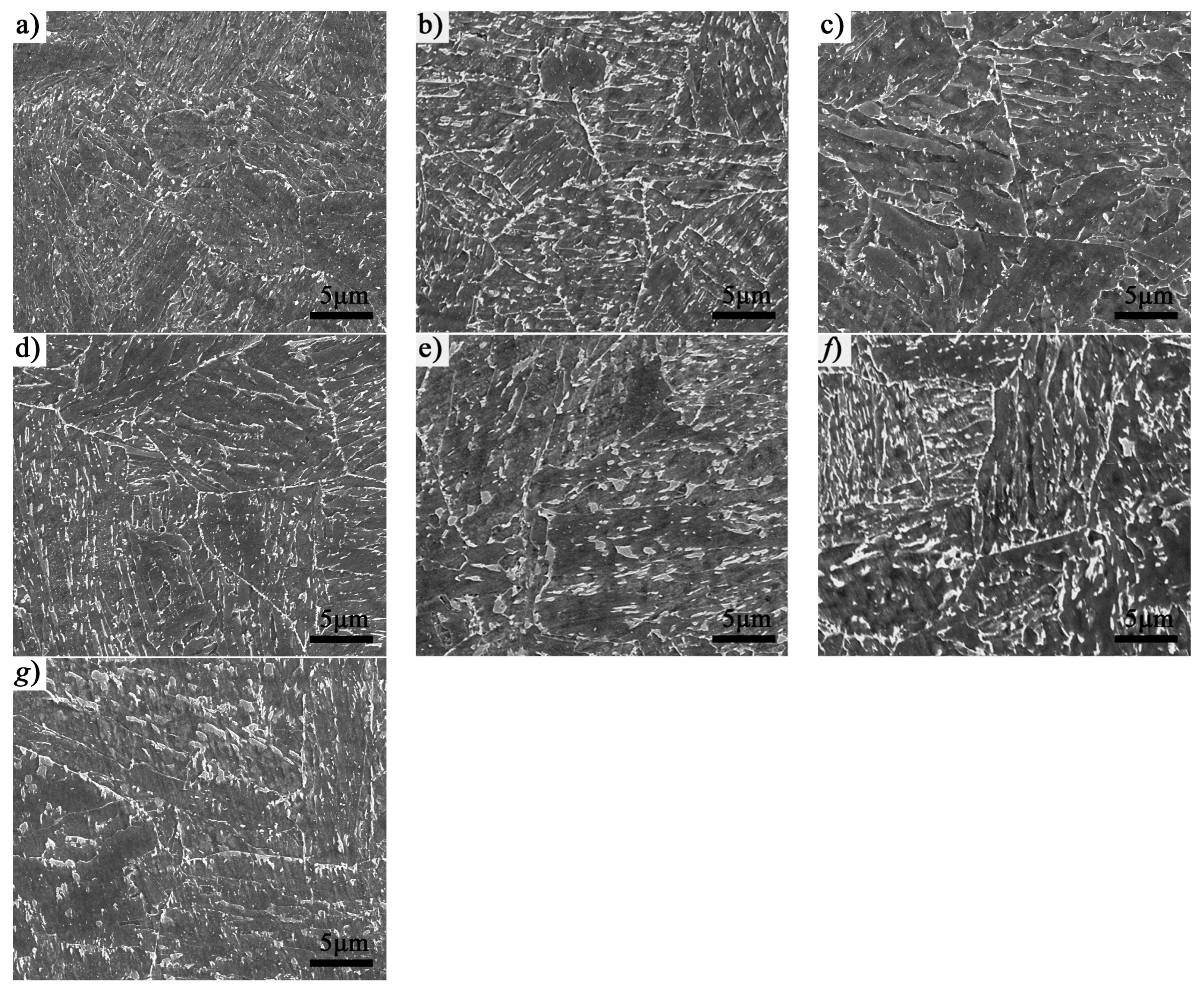


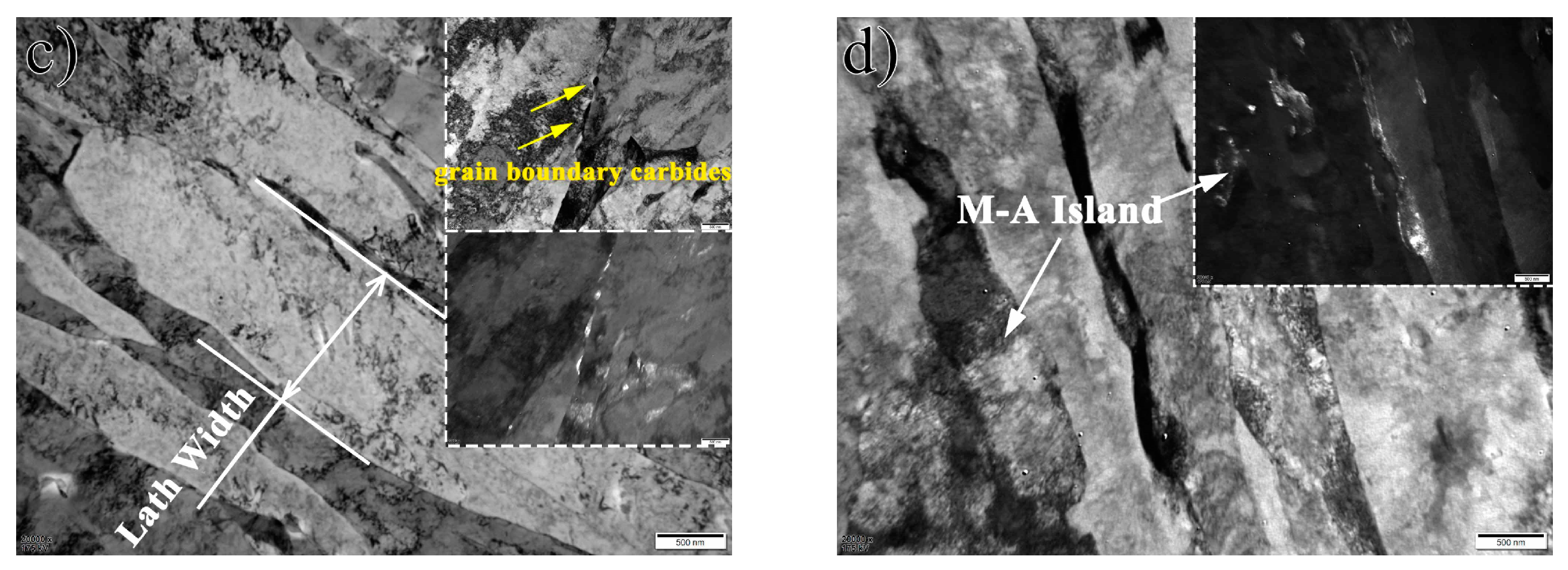
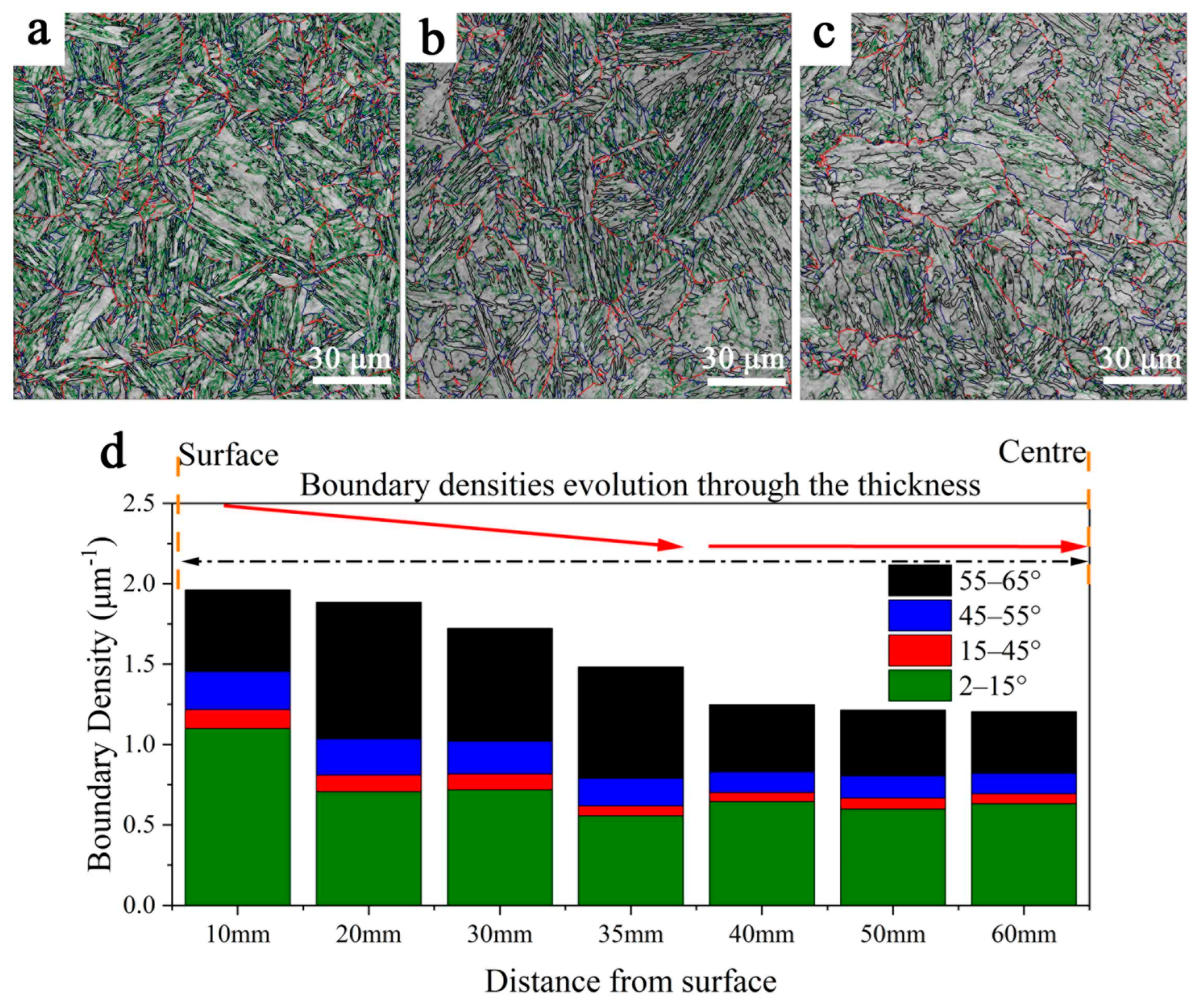
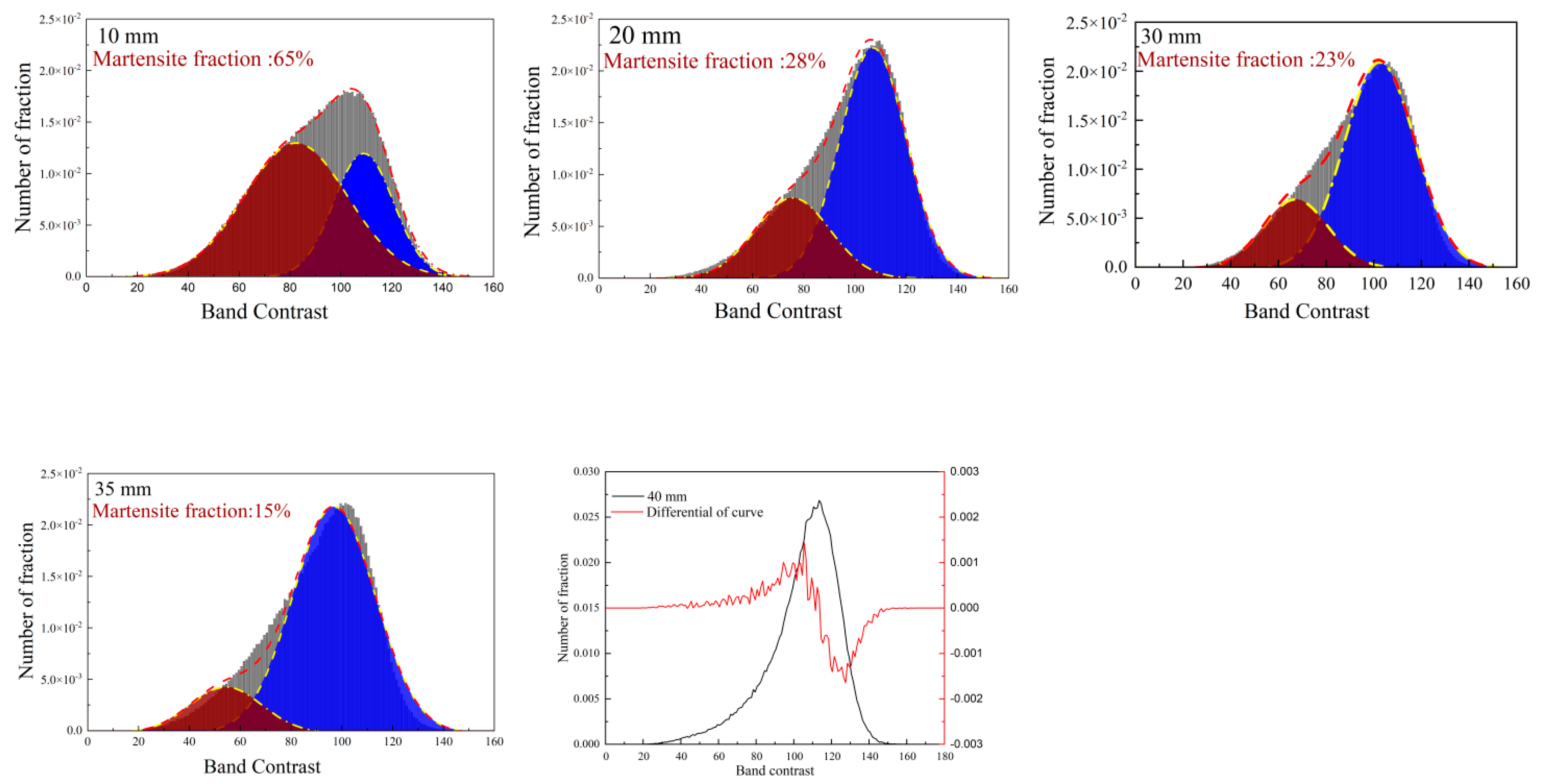



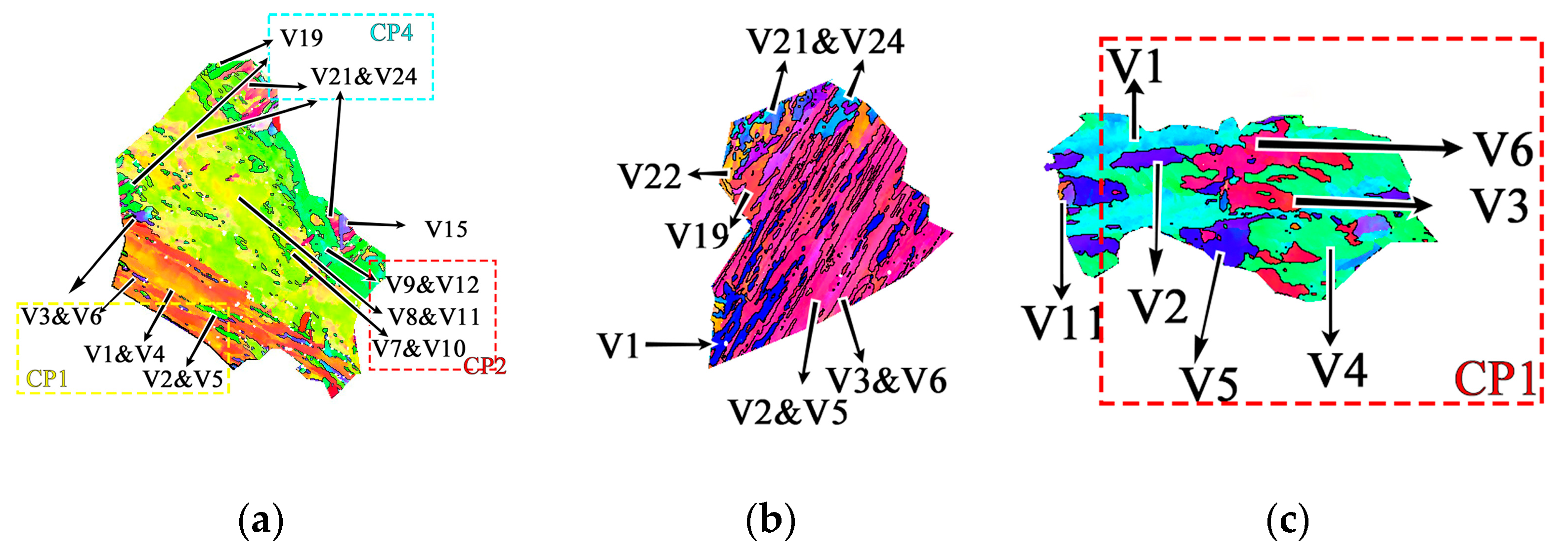
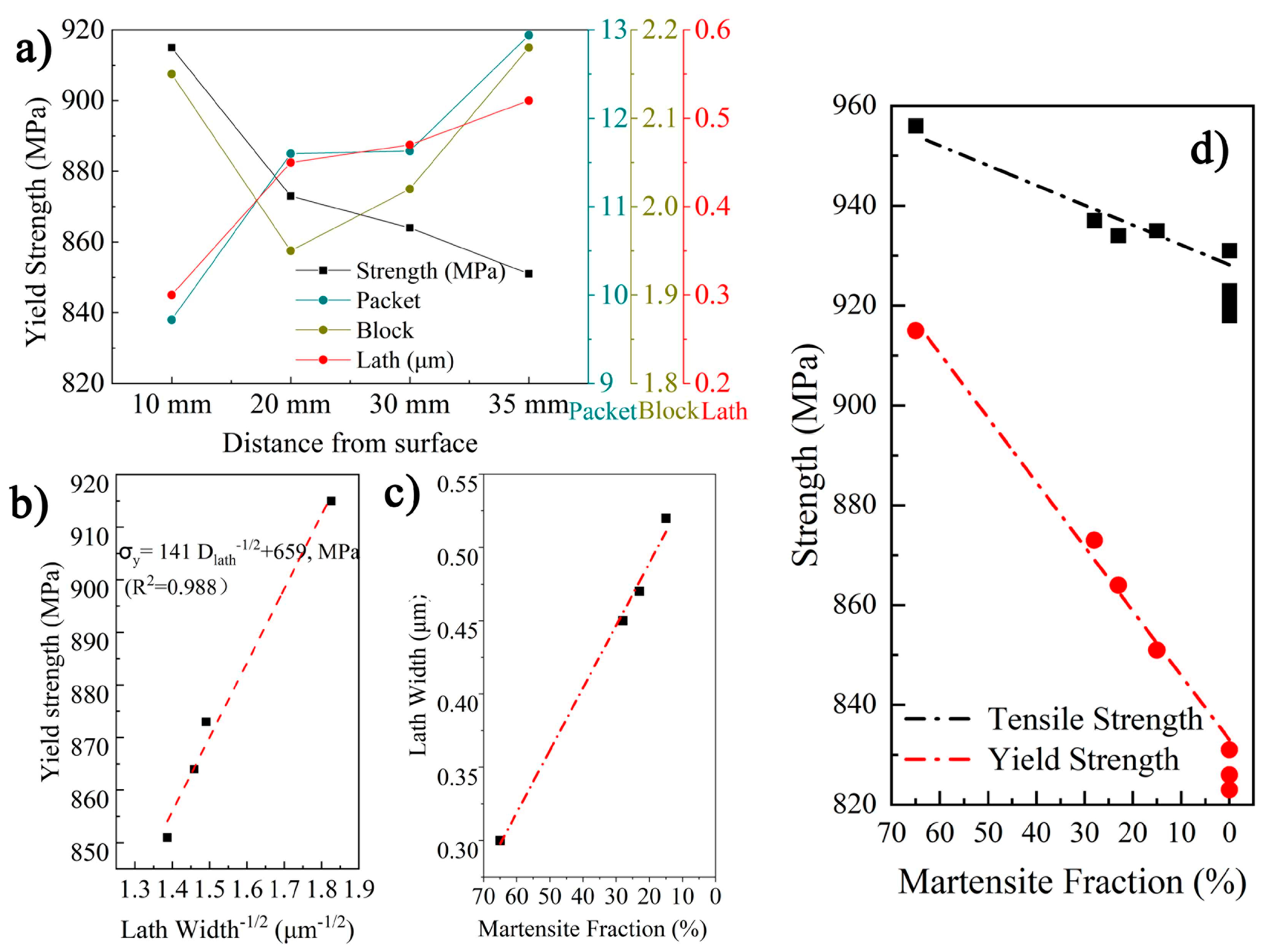
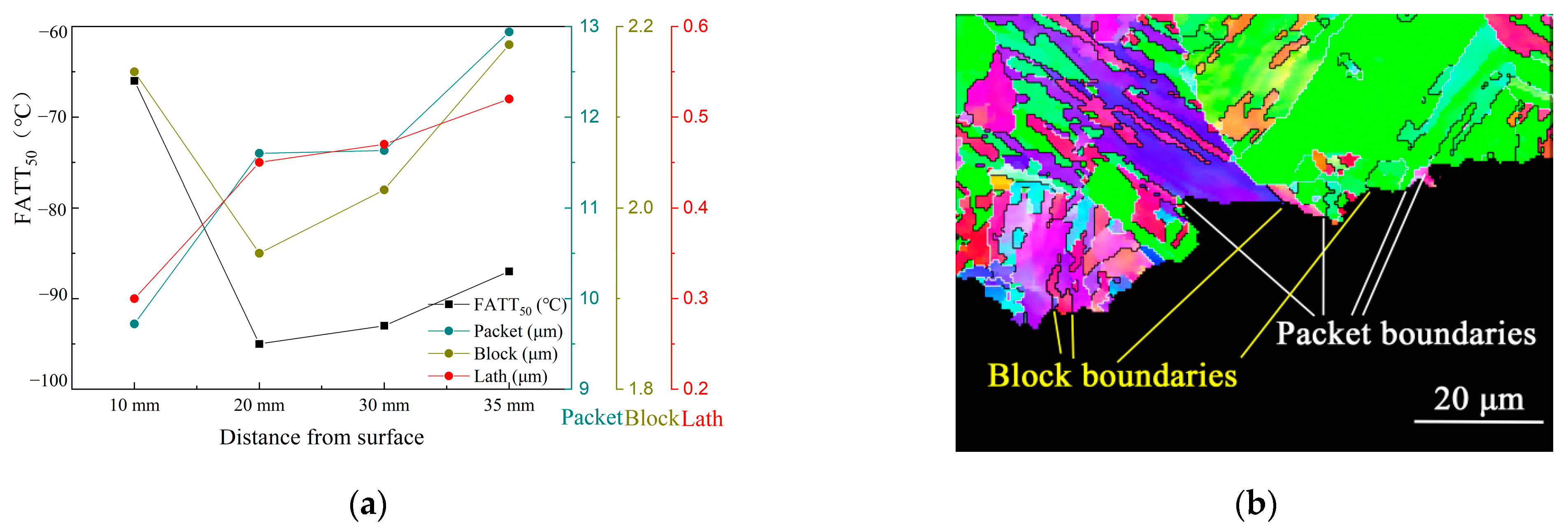

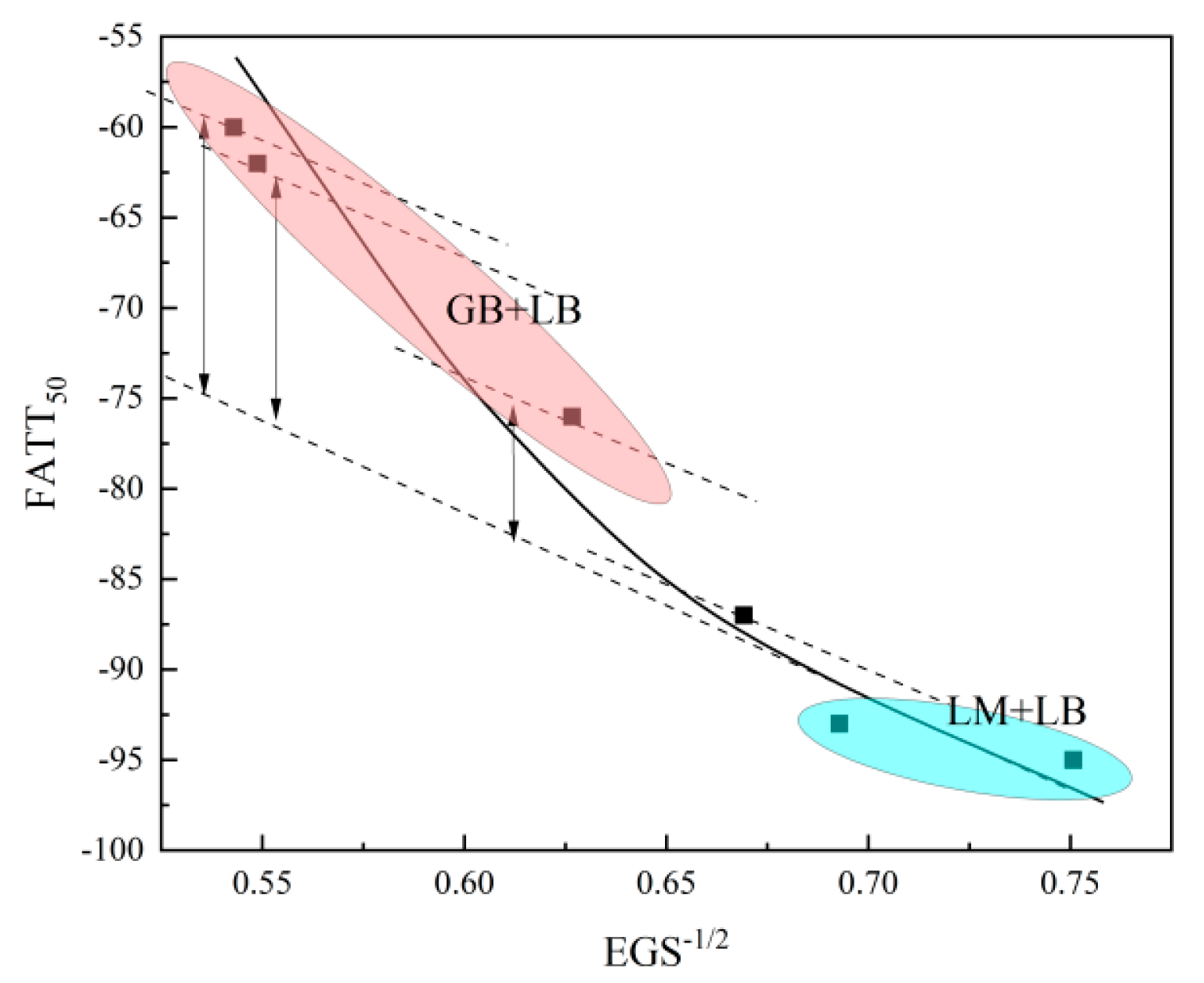
| C | Si | Mn | Ni + Cr + Mo | V + Ti | Al | Fe |
|---|---|---|---|---|---|---|
| 0.08 | 0.3 | 0.8 | 5 | 0.1 | 0.03 | Base |
| Specimens | L1 | L2 | L3 | L4 | L5 | L6 | L7 |
|---|---|---|---|---|---|---|---|
| Distance from the surface (mm) | 10 | 20 | 30 | 35 | 40 | 50 | 60 |
| Location | AGS μm | Martensite Fraction | GB Fraction | M-A Lmax μm | EGS (15°) μm | 1. Packet Size μm | 1. Block Width μm | Lath Width μm |
|---|---|---|---|---|---|---|---|---|
| 10 mm | 22 | 65% | / | / | 2.26 | 9.72 | 2.15 | 0.30 |
| 20 mm | 28 | 28% | / | / | 1.77 | 11.60 | 1.95 | 0.45 |
| 30 mm | 28 | 23% | / | / | 2.08 | 11.63 | 2.02 | 0.47 |
| 35 mm | 32 | 15% | 6% | 0.49 | 2.23 | 12.94 | 2.18 | 0.52 |
| 40 mm | 38 | / | 14% | 0.52 | 2.55 | / | / | / |
| 50 mm | 42 | / | 20% | 0.68 | 3.32 | / | / | / |
| 60 mm | 45 | / | 32% | 0.70 | 3.39 | / | / | / |
| Position | FATT50 (°C) | Calculated Value (°C) | EGS−1/2 (μm−1/2) | GB Fraction | MA Density (μm−2) | P(Dmax > Dc) | −Kd1/2 °C | FATT50 Increment by GB °C |
|---|---|---|---|---|---|---|---|---|
| 10 mm | −66 | −85 | 0.66 | / | / | / | / | / |
| 20 mm | −95 | −96 | 0.75 | / | / | / | −81 | 0 |
| 30 mm | −93 | −90 | 0.69 | / | / | / | −75 | 0 |
| 35 mm | −87 | −86 | 0.67 | 6% | 0.32 | 0.05 | −72 | 1 |
| 40 mm | −76 | −78 | 0.63 | 14% | 0.38 | 0.09 | −68 | 5 |
| 50 mm | −62 | −67 | 0.66 | 20% | 0.26 | 0.16 | −59 | 7 |
| 60 mm | −59 | −59 | 0.55 | 32% | 0.27 | 0.18 | −59 | 15 |
Disclaimer/Publisher’s Note: The statements, opinions and data contained in all publications are solely those of the individual author(s) and contributor(s) and not of MDPI and/or the editor(s). MDPI and/or the editor(s) disclaim responsibility for any injury to people or property resulting from any ideas, methods, instructions or products referred to in the content. |
© 2023 by the authors. Licensee MDPI, Basel, Switzerland. This article is an open access article distributed under the terms and conditions of the Creative Commons Attribution (CC BY) license (https://creativecommons.org/licenses/by/4.0/).
Share and Cite
Guo, K.; Pan, T.; Zhang, N.; Meng, L.; Luo, X.; Chai, F. Effect of Microstructural Evolution on the Mechanical Properties of Ni-Cr-Mo Ultra-Heavy Steel Plate. Materials 2023, 16, 1607. https://doi.org/10.3390/ma16041607
Guo K, Pan T, Zhang N, Meng L, Luo X, Chai F. Effect of Microstructural Evolution on the Mechanical Properties of Ni-Cr-Mo Ultra-Heavy Steel Plate. Materials. 2023; 16(4):1607. https://doi.org/10.3390/ma16041607
Chicago/Turabian StyleGuo, Kaihao, Tao Pan, Ning Zhang, Li Meng, Xiaobing Luo, and Feng Chai. 2023. "Effect of Microstructural Evolution on the Mechanical Properties of Ni-Cr-Mo Ultra-Heavy Steel Plate" Materials 16, no. 4: 1607. https://doi.org/10.3390/ma16041607
APA StyleGuo, K., Pan, T., Zhang, N., Meng, L., Luo, X., & Chai, F. (2023). Effect of Microstructural Evolution on the Mechanical Properties of Ni-Cr-Mo Ultra-Heavy Steel Plate. Materials, 16(4), 1607. https://doi.org/10.3390/ma16041607





